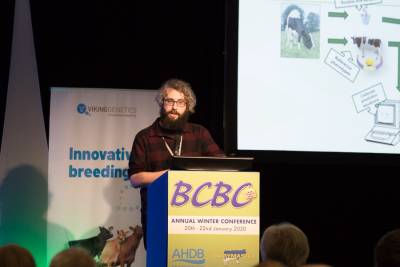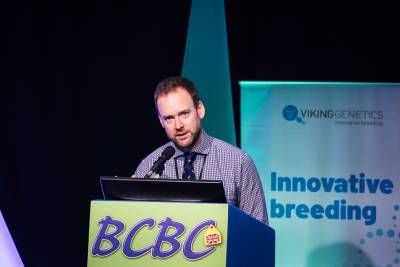

Werner Brand, Geneticist/Programmer from SRUC, opened Dairy Day at the BCBC Conference by explaining how deep learning can be used as a way of solving complex genetic problems. He discussed a project that is looking at predicting the pregnancy status of dairy cows using mid-infrared (MIR) spectroscopy data, routinely collected during milk recording.
Werner’s colleague Dr Scott Denholm looked at the application of deep learning in predicting the TB status of dairy cows using their MIR spectral profiles as part of routine milk recording. Further research is needed but results are very promising, with early diagnosis contributing to a reduced length of a TB breakdown.
Vet and Nuffield Farming Scholar Neil Eastham spoke about the benefits of genomics and how they can help ‘future proof’ UK dairy herds. He stressed that farm specific breeding objectives, combined with selection criteria and breeding strategies, were crucial to maximise genetic gains and financial returns.
He explained that faster genetic gain can be realised with genomics and that the targeted use of the best young genomics bulls was a good tool. Female genomic data can be used to drive decision making - who to breed from and who to put beef to. Animals can be ranked according to the selection criteria in line with the herd’s breeding objectives and there must be scope to deselect the worst animals to realise a return on investment of genomic testing.
The use of sexed dairy and conventional beef semen, together with the sale of surplus low genetic merit heifers, is likely to yield the greatest results with genomics.
Prof. Roel Veerkamp, from Wageningen University in the Netherlands, spoke about the use of multi-breed genomic predictions and their benefits for breeds with smaller reference populations. He explained that using data from other breeds is not straight forward and needs a large amount of records to make it viable.
With new genomic models and QTL information, there is more hope that multi-breed genomic predictions can be made to work for really important cases, but more work is needed to make it practical.
Veterinary surgeon Gavin Tait, from AB Europe, spoke about the practicalities of InVitro Embryo Production (IVP) and gave some practical advice for farmers thinking of using it. He discussed the advantages of IVP, which include: reduced handling of the animal, quick collection, semen flexibility, a quicker turnaround and the potential to collect from pregnant animals up to 12 weeks into gestation.
Gavin spoke about the importance of donor management when looking at factors affecting IVP success. The eight weeks prior to collection have a huge effect on the health and viability of the embryo. Donor cows also need to be not too fat or too thin and on a rising plain of nutrition. He stressed that not all semen was good quality and that quality can vary hugely between different batches from the same bull.
Succession in a farming business needs to be about finding the key person or people that have the skills and desire to take the business forward, said Rob Hitch, Partner at Dodd &Co Accountants in Carlisle. Today’s farmers need many skills to succeed and not everyone will have them.
It’s important to be honest about how much money is being made in a business. Don’t encourage someone to stay at home for ‘beer and petrol money’ if the business can’t support them on a living wage long term, he said. Splitting the business from the assets can make succession easier.
When things are split, they don’t need to be equal, but they do need to be fair, he added. Value can also depend on timing. Having value out of a business when someone is young and starting out can be more valuable than realising that asset later in life, he stressed.
Dairy farmer Patrick Morris-Eyton farms in partnership with his parents and grandmother at Beckside Farm, milking 350 dairy cows (average yield 10,400 litres), with plans to increase the herd size to 400. The farm also includes a herd of 800 breeding ewes, a construction business and an 87 KW hydro-electric scheme.
He spoke about the recent expansion programme at the farm, which included the construction of a new 54-point rotary parlour and cow housing, and how he is future-proofing the business by improving the sustainability of the farm. Patrick stressed that key to this has been increased efficiency on farm to drive profit, reduce carbon emissions and a better work life balance for partners and staff.
Addressing succession on the farm when Patrick was 24 allowed a plan to be put in place and the farm to develop accordingly. He feels it is important for everyone in the farm business, including partners, family members and staff to know where they stand.
Following on from hosting the BCBC Dairy Open Day in August 2019, Neale Sadler concluded the conference by giving a presentation about his decision to convert to A2 milk production and his plans for the future. Neale milks 75 Holstein cows through an A3 Lely robot, installed in 2006.
2020 sees Neale taking the business forward as a new shed with a second robot is completed. He is looking to pasteurise and retail his own milk as a result of A2 Australia, who had previously taken Neale’s milk, withdrawing from the UK market.
Neale is starting with a small venture selling milk that is ‘free from A1’, as he can’t call it A2 milk but knows the market is there. He has good contact with customers and feels that the future is very positive.